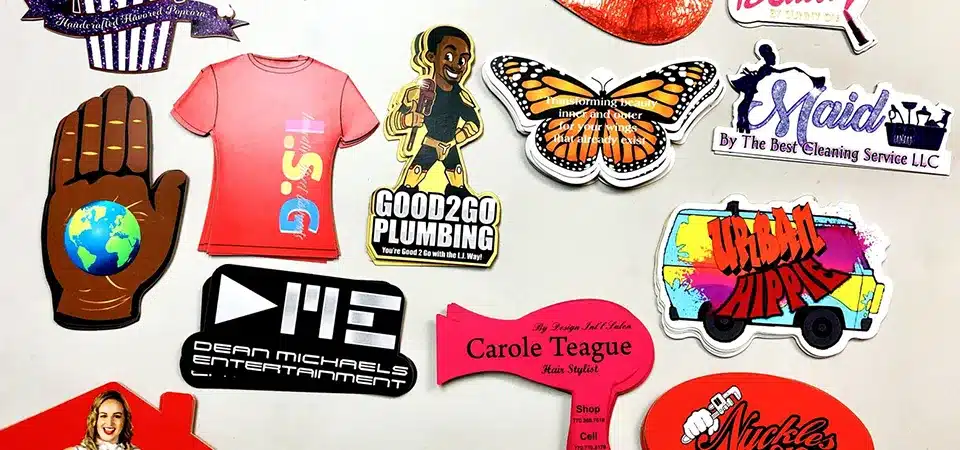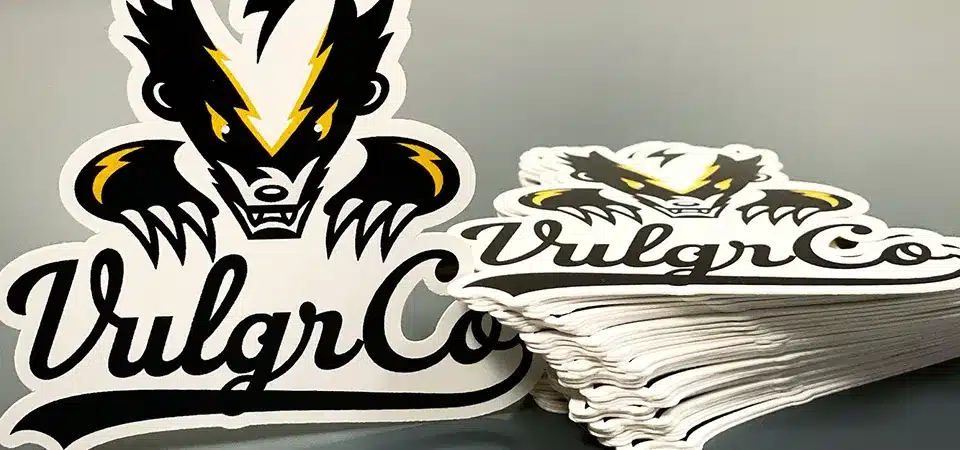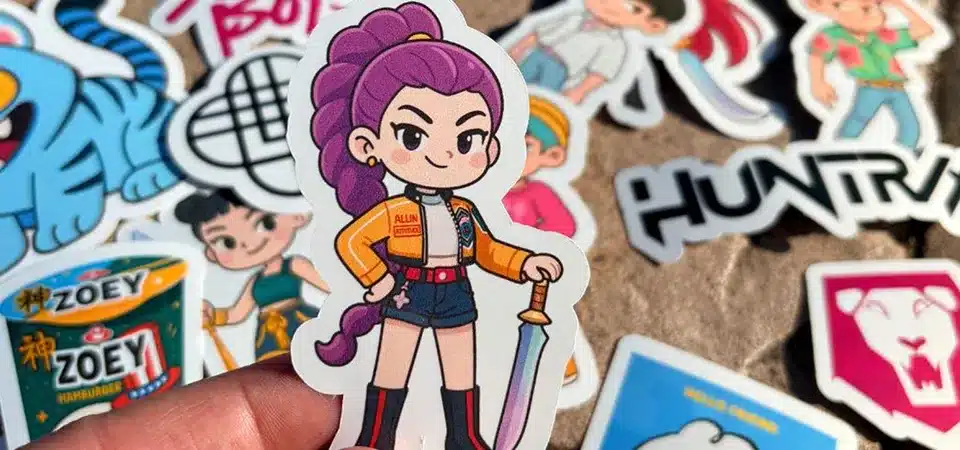You want unique, custom-shaped stickers for your brand, but the price seems high. It's frustrating when you don't know if the extra cost is really worth it.
Die-cut stickers cost more due to the custom work involved. Each unique shape requires a special digital or metal die for precision cutting, plus extra setup time and often uses more durable, premium materials compared to standard square or circle stickers.
As a sticker printer, I see this question all the time. The price difference isn't arbitrary; it's tied directly to the specific, hands-on process required to create that perfect custom shape. Many people think a sticker is just a sticker, but the journey from a digital design to a physical, custom-shaped product involves specialized tools, materials, and time. To really understand the value, we need to look at what makes a die-cut sticker different from a regular one, and how each step adds to the final cost.
What Makes Die-Cut Stickers Different From Regular Stickers?
You hear terms like "die-cut" and "kiss-cut," and it's confusing. Ordering the wrong type is an easy and costly mistake to make for your project.
The key difference is how they are cut. A die-cut sticker is cut completely through both the sticker and the backing paper, creating a custom-shaped piece. Regular stickers are often squares, circles, or kiss-cut on a larger sheet.
Understanding the cut is the first step to understanding the cost. When I talk to clients, clarifying this difference is my first priority to ensure they get exactly what they envision. A die-cut sticker is a standalone item, perfect for handing out at events or including in packages. A regular sticker, like a kiss-cut one, is designed to be peeled off a sheet. This fundamental difference in the final product begins with a very different cutting process.
The Cut Defines the Sticker
The terms can be confusing, but it all comes down to the blade. Think of it this way: one cut creates the final product's shape, while the other just makes it easy to peel.
- Die-Cut: The cutting process goes through all layers—the top laminate, the sticker material itself, and the paper backing. The result is a single, shaped sticker. The edge of the sticker is also the edge of the backing paper. This is what gives it a premium, finished look.
- Regular Stickers (Kiss-Cut): This is the most common alternative. The blade just "kisses" the surface, cutting through the sticker material but leaving the paper backing intact. This is how sticker sheets are made. You can have a custom shape, but it will live on a square or rectangular backing until you peel it off.
| Feature | Die-Cut Sticker | Regular Sticker (Kiss-Cut on a Sheet) |
|---|---|---|
| Cut Depth | Cuts through sticker and backing | Cuts through sticker layer only |
| Final Product | A single, custom-shaped sticker | A sheet of paper with peelable stickers on it |
| Best Use Case | Giveaways, retail products, branding | Sticker sheets for sale, planner stickers |
How the Cutting Process Affects the Cost?
You assume cutting a sticker is a simple step. But you're surprised when the quote reflects a complex process you didn't account for, driving the price up.
The cutting process for a die-cut sticker requires a custom "die." This can be a physical metal die or a custom digital cutting path for a laser. Both require special setup, calibration, and more machine time per sticker.
This is the real heart of the extra cost. Unlike a standard paper cutter that just makes straight lines, a die-cutter has to perfectly trace your custom design. I always tell my clients to think of it like tracing a drawing with a craft knife versus slicing it with a guillotine. The first option gives you a custom shape but takes far more time and precision.
Creating the Custom Die
For every single new shape, we have to create a unique cutting guide. This is the "die," and there are two main types:
- Metal Dies: For very large, traditional print runs (tens of thousands of stickers), a physical metal die is created. It’s like a custom-shaped cookie cutter. The setup cost for this is high because you have to forge a unique metal tool. But once it's made, it can stamp out stickers very quickly.
- Digital Die-Cutting: This is what my shop and most modern printers use. We use a plotter or a laser cutter. There's no physical die, but we have to create a precise vector path in the software that tells the machine's blade or laser exactly where to cut. This process is slower per sticker because the machine has to trace every curve and corner individually. The setup time involves calibrating the machine for the specific shape and material to ensure a perfect cut without burning or tearing.
| Cutting Method | Setup Cost | Per-Sticker Speed | Best For |
|---|---|---|---|
| Metal Die | High | Very Fast | Massive runs (50,000+) of one design |
| Digital Die-Cut | Low | Slower | Small to large runs, complex shapes |
Do Materials and Finishes Increase the Price?
You picked a cool holographic finish for your sticker. But when you get the quote, the price has jumped significantly, and you're not sure why.
Yes, materials and finishes are a major factor. Die-cut stickers are almost always printed on premium vinyl, not paper, for durability. Special finishes like holographic, glitter, or matte laminates cost more but add significant value and protection.
Since die-cut stickers are meant to be high-impact, standalone items, using cheap materials defeats the purpose. I always recommend durable vinyl because it feels professional and can withstand water and sunlight. Think about it: a paper sticker might get ruined the first time it gets wet, but a vinyl one on a water bottle will last for years. That durability comes from a more expensive base material.
The Base Material Matters
The foundation of a good sticker is the material it's printed on. The cost can vary widely.
- Paper: This is the cheapest option. It’s fine for indoor use where it won't be handled much, like on product packaging that will be discarded.
- Durable Vinyl/PET: This is the industry standard for die-cut stickers. It's waterproof, weather-resistant, and tear-resistant. It costs more per sheet than paper but provides a much longer lifespan and a more premium feel.
- Specialty Materials: This includes holographic, glitter, clear, prismatic, or mirror vinyl. These materials have a complex manufacturing process, making them the most expensive option, but they deliver a unique look that really stands out.
The Power of Lamination
A finish, or laminate, is a thin protective layer applied over the printed sticker. It's another cost but a crucial one. It protects the printed ink from scratches, fading from UV sunlight, and moisture. A matte or gloss laminate adds to the final price but can double or triple the effective life of a sticker.
How Order Quantity and Shape Complexity Impact Pricing?
You only need 50 stickers, but the price per piece seems outrageous. It feels like you're being punished for not ordering thousands of them.
Setup costs are fixed for each job. Spreading that cost over 5,000 stickers makes each one cheap. Spreading it over 50 makes each much more expensive. More complex shapes also take more machine time to cut, increasing the cost.
This is a concept I explain to clients every day. The most expensive part of a small sticker run is not the material—it's the labor and machine time for setup. Whether you order 50 stickers or 5,000, we still have to go through the exact same setup process.
The Economics of Setup Costs
Here’s what goes into setting up a job:
- File Prep: We check your artwork and create the digital cutline.
- Machine Calibration: We load the correct material and calibrate the printer and the cutter.
- Test Run: We print and cut a few test stickers to ensure the alignment and cut depth are perfect.
This process can take 15-30 minutes. If your order is only 50 stickers, the cost of that 30 minutes of expert labor is divided among those 50 pieces. If your order is 5,000, that same cost is divided by 5,000, making the per-piece setup cost tiny.
Why Intricate Shapes Cost More
The complexity of your design's cutline directly impacts the price. A cutting machine can trace a simple circle or square very quickly. However, if your design has lots of sharp corners, tiny details, or intricate curves, the machine has to slow down to maintain precision. The more time your job takes on the cutting machine, the higher the cost will be. A sticker with a simple outline might take 2 seconds to cut, while a complex one could take 10 seconds. That difference adds up over the entire run.
Are Die-Cut Stickers Worth the Higher Price?
You know they cost more, but you're still wondering if they are actually worth it. Maybe a cheaper square sticker would get the job done for your brand.
Absolutely. Their unique, custom shape makes them feel more like a gift than an advertisement. They elevate your brand's perceived value for retail, packaging, or promotions, making the investment worthwhile for a professional presentation.
I've seen it time and time again: when someone gets a sticker shaped like a company's logo, they are far more likely to keep it and use it. It doesn't look like a generic label; it looks like a custom piece of merchandise. That positive first impression is where the real value lies.
Elevating Brand Perception
The difference in perception between a standard sticker and a die-cut sticker is huge.
- Professionalism: A sticker cut to the shape of your design looks intentional and high-quality. It shows you've invested in the details of your brand.
- Memorability: Our brains are drawn to unique shapes. A custom-shaped sticker is more eye-catching and memorable than a generic square or circle with a logo printed on it.
- Perceived Value: Because it looks more premium, customers value it more. They are more likely to stick it on a laptop or water bottle, turning them into a walking advocate for your brand.
For one of my clients, a local bakery, we switched from a square label on their pastry boxes to a die-cut sticker shaped like their croissant logo. They told me customers immediately started commenting on the "cute" new packaging, and they saw an increase in social media tags. That's the power of investing in presentation. The ROI isn't just in the sticker; it's in the enhanced customer experience and organic marketing.
Conclusion
Die-cut stickers cost more due to custom cutting, materials, and setup. But their professional look and branding power make them a valuable investment for any serious business.













